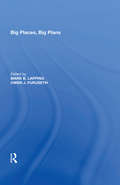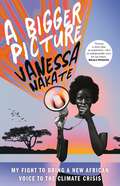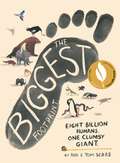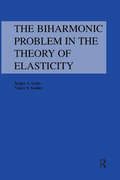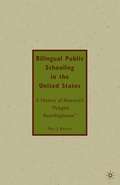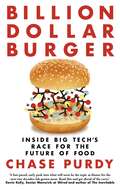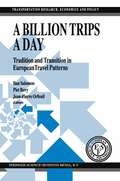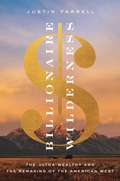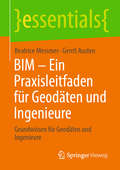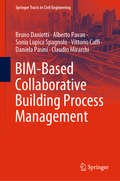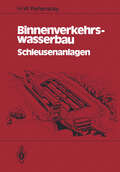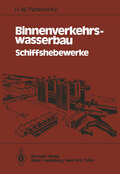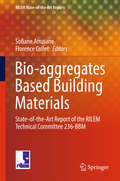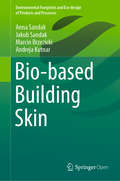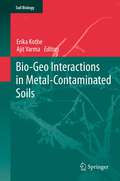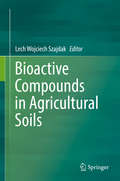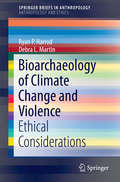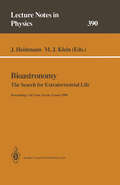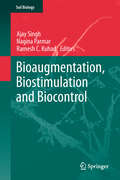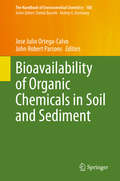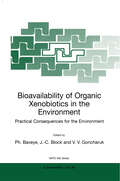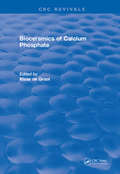- Table View
- List View
Big Places, Big Plans
by Mark B. LappingWith origins in the late 1960s, a 'quiet revolution' in land use planning and control has taken hold across North America. First seen as a manifestation of the environmental movement, the revolution prompted governments at several levels to attempt to protect critical areas and vulnerable natural resources. Many of the most dramatic and far-reaching shifts in planning regimes have occurred in large-scale, environmentally unique or sensitive regions. It is these big places, looming large in the American and Canadian psyches, that are the focus of this edited volume. Each of the chapters reflects on the contemporary challenge of environmental and land use planning. Ten leading distinguished scholars here provide thoughtful analyses and critical insights into the processes and contexts shaping the innovative planning and policy schemes in seven regional landscapes.
A Bigger Picture: My Fight to Bring a New African Voice to the Climate Crisis
by Vanessa Nakate'Vanessa Nakate continues to teach a most critical lesson. She reminds us that while we may all be in the same storm, we are not all in the same boat.' - Greta ThunbergIn A Bigger Picture, Vanessa Nakate exposes the shortcomings of our global discussions around climate change, which consistently envisage the environmental crisis as a problem for future generations. Such an image is only possible through the erasure of the voices of people living in the Global South, where environmental disasters are already having a devastating impact on communities, and especially on women.This is one of the great injustices of the climate crisis: those who have contributed the least to its creation are now suffering its consequences most severely. Despite this, people from the Global South – and people of colour from across the world – are often expunged from the picture of climate activism, as typified by Vanessa's own erasure from a press photograph at Davos in 2020. As she explains, 'we are on the front line, but we are not on the front page.'Witnessing the destructive effects of global warming in her own community propelled Vanessa to become the first climate striker in Uganda at just twenty-one years old, despite risks to her personal safety. In this exceptional book, she traces the links between the climate crisis and anti-racism, feminism, economics and even extremist radicalization, revealing how our best hope of saving our planet is to work together across continents. In telling the inspiring personal story of how she found her voice, Vanessa shows readers that no matter your age, location or skin colour, you can be an effective activist.
The Biggest Footprint: Eight billion humans. One clumsy giant.
by Rob Sears Tom SearsThere are eight billion of us humans. All breathing, eating, fidgeting and thinking deep thoughts. It’s an unimaginably large number. Or is it? Say hello to the mega human: all the people in the world smooshed into one spectacular giant. Even though it’s not the smartest of creatures, the mega human is slowly beginning to understand the problems it has created for Planet Earth’s future . . . and how it might be able to fix them. Making use of brain-bending stats and smoosh theory, The Biggest Footprint is a journey of self-discovery suitable for anyone and everyone identifying as human.
Biharmonic Problem in the Theory of Elasticity
by Sergey A. LurieThis reference work offers a method of deriving exact solutions to the biharmonic equation in the context of elasticity problems, and proposes a number of new solutions. Beginning with an in-depth presentation of a general mathematical model, this text proceeds to outline specific applications, extending the developed method to special harmonic problems of mechanics for conjugated domains. All applications are illustrated with numerical examples.
Biharmonic Problem in the Theory of Elasticity
by Sergey A. LurieThis reference work offers a method of deriving exact solutions to the biharmonic equation in the context of elasticity problems, and proposes a number of new solutions. Beginning with an in-depth presentation of a general mathematical model, this text proceeds to outline specific applications, extending the developed method to special harmonic problems of mechanics for conjugated domains. All applications are illustrated with numerical examples.
Bilinear Integrable Systems: Proceedings of the NATO Advanced Research Workshop on Bilinear Integrable Systems: From Classical to Quantum, Continuous to Discrete St. Petersburg, Russia, 15-19 September 2002 (pdf) (NATO Science Series II: Mathematics, Physics and Chemistry #201)
by Ludwig Faddeev Pierre Van Moerbeke Franklin LambertBilingual Public Schooling in the United States: A History of America's "Polyglot Boardinghouse"
by P. RamseyThis history of one of the most contentious educational issues in America examines bilingual instruction in the United States from the common school era to the recent federal involvement in the 1960s and 1970s. Drawing from school reports, student narratives, legal resources, policy documents, and other primary sources, the work teases out the underlying agendas and patterns in bilingual schooling during much of America s history. The study demonstrates clearly how the broader context - the cultural, intellectual, religious, demographic, economic, and political forces - shaped the contours of dual-language instruction in America between the 1840s and 1960s. Ramsey s work fills a crucial void in the educational literature and addresses not only historians, linguists, and bilingual scholars, but also policymakers and practitioners in the field.
Billion Dollar Burger: Inside Big Tech's Race for the Future of Food
by Chase PurdyA fast-paced, gripping insider account of the entrepreneurs and renegades racing to bring lab-grown meat to the world.The trillion-dollar meat industry is one of our greatest environmental hazards; it pollutes more than all the world's fossil-fuel-powered cars. Global animal agriculture is responsible for deforestation, soil erosion and more emissions than air travel, paper mills and coal mining combined. It also depends on the slaughter of more than 60 billion animals per year, a number that is only increasing as the global appetite for meat swells. The whole world seems to be sleepwalking into a food crisis. But a band of doctors, scientists, activists and entrepreneurs have been racing to end animal agriculture as we know it, hoping to fulfill a dream of creating meat without ever having to kill an animal. This is the story of a group of seven vegans quietly working to solve one the most pressing issues we face today, creating the biggest upheaval to the food business in decades along the way. In Billion Dollar Burger, Chase Purdy explores the companies at the cutting edge of the nascent food technology sector, from polarizing activist-turned-tech CEO Josh Tetrick to lobbyists and regulators on both sides of the issue. Billion Dollar Burger follows the people fighting to upend our food system as they butt up against the entrenched interests fighting viciously to stop them. It will take readers on a truly global journey from Silicon Valley to China, by way of Israel and the UK.The stakes are monumentally high: cell-cultured meat is the best hope for sustainable food production, a key to fighting climate change, a gold mine for the companies that make it happen and an existential threat for the farmers and meatpackers that make our meat today.
A Billion Trips a Day: Tradition and Transition in European Travel Patterns (Transportation Research, Economics and Policy)
by I. Salomon P. H. Bovy J. P. OrfeuilA Billion Trips a Day: Tradition and Transition in European Travel Patterns consists of twenty-four original chapters developed by a network of transport professionals in a coordinated manner. The three parts of the book are: European Mobility Patterns; Dimensions of European Mobility, and National Perspectives. Mobility in fourteen countries is described and ten chapters of analysis compare the major dimensions of travel across Europe, which is seen as a laboratory for transport policies. A Billion Trips a Day: Tradition and Transition in European Travel Patterns questions the uniqueness of European travel and transport policies and demonstrates that, in many ways, Europe is different from other developed economies. However, there are side dissimilarities within Europe. The authors take a deep look at the underlying factors which affect travel behavior, with the objective of providing the necessary information for policy making. The comparative chapters of Part II provide an analysis based on national perspectives of the role of the time dimension travel; automobile ownership and use; commuting; public transport; and international travel. They also review the transport policies applied in Europe, explaining why some policies work in some places, while failing in others.
Billionaire Wilderness: The Ultra-Wealthy and the Remaking of the American West (Princeton Studies In Cultural Sociology Ser. #83)
by Justin FarrellA revealing look at the intersection of wealth, philanthropy, and conservationBillionaire Wilderness takes you inside the exclusive world of the ultra-wealthy, showing how today's richest people are using the natural environment to solve the existential dilemmas they face. Justin Farrell spent five years in Teton County, Wyoming, the richest county in the United States, and a community where income inequality is the worst in the nation. He conducted hundreds of in-depth interviews, gaining unprecedented access to tech CEOs, Wall Street financiers, oil magnates, and other prominent figures in business and politics. He also talked with the rural poor who live among the ultra-wealthy and often work for them. The result is a penetrating account of the far-reaching consequences of the massive accrual of wealth, and an eye-opening and sometimes troubling portrait of a changing American West where romanticizing rural poverty and conserving nature can be lucrative—socially as well as financially.Weaving unforgettable storytelling with thought-provoking analysis, Billionaire Wilderness reveals how the ultra-wealthy are buying up the land and leveraging one of the most pristine ecosystems in the world to climb even higher on the socioeconomic ladder. The affluent of Teton County are people burdened by stigmas, guilt, and status anxiety—and they appropriate nature and rural people to create more virtuous and deserving versions of themselves. Incisive and compelling, Billionaire Wilderness reveals the hidden connections between wealth concentration and the environment, two of the most pressing and contentious issues of our time.
BIM – Ein Praxisleitfaden für Geodäten und Ingenieure: Grundwissen für Geodäten und Ingenieure (essentials)
by Beatrice Messmer Gerrit AustenZiel dieses Essentials ist es, Basiswissen zu Building Information Modeling (BIM) für den Fachbereich der Geodäsie und deren Nachbardisziplinen aus nationaler sowie internationaler Literatur zusammenzufassen und praktische Empfehlungen daraus abzuleiten. Der zunehmende Digitalisierungsgrad bei Bauvorhaben durch die Anwendung von BIM und das steigende Automatisierungspotential klassischer geodätischer Tätigkeiten begründen die Notwendigkeit, betroffene Aufgaben- und Tätigkeitsfelder in der Vermessung weiter zu entwickeln.
BIM-Based Collaborative Building Process Management (Springer Tracts in Civil Engineering)
by Bruno Daniotti Alberto Pavan Sonia Lupica Spagnolo Vittorio Caffi Daniela Pasini Claudio MirarchiThe book reports on the great improvements in the information and knowledge management due to the digitalization of the building sector. By summarizing several research projects addressing the implementation of BIM in different stages of the building process, and the definition of standards at Italian, European and international levels for managing information relying on the implementation of BIM-based processes, it showcases the efforts, especially within the Italian building sector, to build a standardized structure of information and develop tools for collecting, sharing and exchanging information between stakeholders involved in different stages of the building process, so as to enhance the storage, traceability, usability and re-usability of information management. Further, it presents an enhanced use of information that relies on the adoption of the standardized structure of information, and proposes dedicated applications for automating the process of information fruition. Lastly, it features a digital platform for different stakeholders in the building sector, such as manufacturers, producers and construction companies.
Binnenverkehrswasserbau: Schiffshebewerke
by H.W. PartensckyAnfang der zwanziger Jahre, nach Ende des 1. Weltkrieges, wurde in fast allen europäischen Ländern mit dem Ausbau der vorhandenen Bin nenwasserstraßen begonnen. Diese Entwicklung wurde nach 1950 in ver stärktem Maße fortgesetzt und dauert bis zum heutigen Tage an. Damit gewinnt das europäische Binnenwasserstraßennetz als Verbindung der Seehäfen mit den Umschlags plätzen des Binnenlandes und als Verkehrs weg für den zwischenstaatlichen Gütertransport in zunehmendem Maße an Bedeutung. Bei der Planung neuer Wasserstraßen und beim Entwurf der als Abstiegs bauwerke dienenden Schleusen und Hebewerke sind im Hinblick auf die Sicherheit des Schiffsverkehrs bestimmte Grenzwerte einzuhalten und Bemessungskriterien anzuwenden, die sich zum Teil aus theoretischen Uberlegungen, aber auch aus praktischen Erfahrungen an bestehenden Anlagen ergeben. Diese müssen vom planenden Ingenieur beim Entwurf eines neuen Schiffahrtskanals und seiner Abstiegsbauwerke beachtet werden. Gleichzeitig werden bei ihrer Einhaltung der erreichbaren Lei stungsfähigkeit der Wasserstraße gewisse Grenzen gesetzt. In der Fachliteratur der zwanziger Jahre wurden die derzeit gültigen Erkenntnisse für den Bau von Schiffahrtskanälen, Schleusen und Hebe werken in dem vom Springer-Verlag im Jahre 1921 herausgegebenen Buch von F. ENGELHARD "Kanal- und Schleusenbau" und dem im gleichen Ver lag erschienenen klassischen Werk von o. FRANZIUS "Verkehrswasserbau" dargelegt. In den folgenden Büchern von H. DEHNERT über "Schleusen und Hebewer ke" (Springer-Verlag, 1954) und H. PRESS über "Binnenwasserstraßen und Binnenhäfen" (Verlag von Wilh. Ernst & Sohn, 1956) wurde der wei teren Entwicklung bis Mitte der fünfziger Jahre Rechnung getragen.
Bio-aggregates Based Building Materials: State-of-the-Art Report of the RILEM Technical Committee 236-BBM (RILEM State-of-the-Art Reports #23)
by Sofiane Amziane Florence ColletThe work of the RILEM Technical Committee (TC -236 BBM) was dedicated to the study of construction materials made from plant particles. It considered the question whether building materials containing as main raw material recyclable and easily available plant particles are renewable. This book includes a state-of-the-art report and an appendix. The state-of-the-art report relates to the description of vegetal aggregates. Then, hygrothermal properties, fire resistance, durability and finally the impact of the variability of the method of production of bio-based concrete are assessed. The appendix is a TC report which presents the experience of a working group. The goal was to define testing methods for the measurement of water absorption, bulk density, particle size distribution, and thermal conductivity of bio aggregates. The work is based on a first round robin test of the TC-BBM where the protocols in use by the different laboratories (labs) are compared. p>
Bio-based Building Skin (Environmental Footprints and Eco-design of Products and Processes)
by Anna Sandak Jakub Sandak Marcin Brzezicki Andreja KutnarThis book provides a compendium of material properties, demonstrates several successful examples of bio-based materials’ application in building facades, and offers ideas for new designs and novel solutions. It features a state-of-the-art review, addresses the latest trends in material selection, assembling systems, and innovative functions of facades in detail. Selected case studies on buildings from diverse locations are subsequently presented to demonstrate the successful implementation of various biomaterial solutions, which defines unique architectural styles and building functions. The structures, morphologies and aesthetic impressions related to bio-based building facades are discussed from the perspective of art and innovation; essential factors influencing the performance of materials with respect to functionality and safety are also presented. Special emphasis is placed on assessing the performance of a given facade throughout the service life of a building, and after its end. The book not only provides an excellent source of technical and scientific information, but also contributes to public awareness by demonstrating the benefits to be gained from the proper use of bio-based materials in facades. As such, it will appeal to a broad audience including architects, engineers, designers and building contractors.
Bio-Geo Interactions in Metal-Contaminated Soils (Soil Biology #31)
by Erika Kothe and Ajit VarmaMetal contamination is an increasing ecological and eco-toxicological risk. Understanding the processes involved in metal mobilization, sorption and mineralization in soils are key features for soil bioremediation.Following an introduction to the physical, chemical and biological components of contaminated soils, various chapters address the interactions of soil, microorganisms, plants and the water phase necessary to transfer metals into biological systems. These include topics such as potential hazards at mining sites; rare earth elements in biotic and abiotic acidic systems; manganese redox reactions; biomineralisation, uranium in seepage water; metal-resistant streptomycetes; mycorrhiza in re-forestation; metal (hyper)accummulation in plants; microbial metal uptake; and their potential for bioremediation.This book will be of interest to soil biologists, geologists and chemists, researchers and graduate students, as well as consulting companies and small enterprises involved in bioremediation.
Bioactive Compounds in Agricultural Soils
by Lech Wojciech SzajdakThis volume looks at the impact that different cropping systems and tillage have on soil’s biologically active substances. It considers how phytotoxins accumulate and can inhibit the development of cultivated plants. Coverage explores the continuous cropping of rye, crop rotation, no tillage, and conventional tillage. It offers a comprehensive, comparative approach to allelopathic plant-soil interactions.The authors focus on free and bounded biologically active substances such as amino acids, auxins, humic and fulvic acids, transient radicals, and enzymes in light sand soils fertilized with different mineral and organic fertilizers.The chapters address fundamental questions relevant to the environmental challenges we face today and will deal with in the future. The results involve asking basic questions motivated by soil's chemical and biochemical processes. The answers will lead to the improvement of the quality of soil’s organic matter, which, in turn, can lead to increased crop yields.Readers will come to understand the relationship between ecological processes and environmental change on individual levels of biocomplexity as well as on systems in their entirety. The title is ideal for students and teachers for laboratory practical classes. Soil scientists, biochemists, chemists, plant ecophysiologists, “Natural Products” organic chemists, and other environmental scientists and specialists will also find it useful.
Bioarchaeology of Climate Change and Violence: Ethical Considerations (SpringerBriefs in Anthropology #6)
by Ryan P. Harrod Debra L. MartinThe goal of this monograph is to emphasize with empirical data the complexity of the relationship between climate change and violence. Bioarchaeology is the integration of human skeletal remains from ancient societies with the cultural and environmental context. Information on mortality, disease, diet and other factors provide important data to examine long chronologies of human existence, particularly during periods of droughts and life-threatening climate changes. Case studies are used to reconstruct the responses and short and long-term adaptations made by groups before, during and after dramatic changes in weather and climate. Interpersonal and group violence is also analyzed. The authors find that while in some cases there is an increase in trauma and violence, in other cases there is not. Human groups are capable of avoiding violent altercations and increasing broad networks of cooperation that help to mitigate the effects of climate change. A case study from the U.S. Southwest is provided that shows the variable and surprising ways that ancient farmers in the past dealt with long term droughts.
Bioastronomy: The Search for Extraterrestrial Life — The Exploration Broadens (Lecture Notes in Physics #390)
by Jean Heidmann Michael J. KleinThis book collects together a selection of the best papers presented at the Third International Bioastronomy Symposium held in 1990. The subject is bioastronomy, the search for life in the universe, andthe book is devided according to the five main stages of life as recognized by this new branch of science: cosmic organic, prebiotic, primitive biological, and advanced. Thereader will find here the most recent results obtained by top specialists from all over the world on hot topics such as the formation and discovery of planets, organic chemistry in meteorites and comets, prebiotic chemistry in the atmosphere of Titan, the search for primitive life in the permafrost of Mars, and, SETI itself, the search for extraterrestrial intelligence. Complemented by live discussions each presentation forms a review of the state-of-the-art treatment of a particular area and also looks toward those developments in bioastronomywhich will surely be realized in the next few years.
Bioaugmentation, Biostimulation and Biocontrol (Soil Biology #10)
by Ajay Singh, Nagina Parmar and Ramesh C. KuhadBioaugmentation, biostimulation and biocontrol approaches using microbial inoculants, biofertilizers, biochemicals and organic amendments improve soil biology, fertility and crop productivity by providing plant growth-promoting nutrients and suppressing soil-borne diseases and plant-parasitic nematodes. Our knowledge of microbial diversity and its function in soils has been increased tremendously due to the availability of a wealth of data gained through recent advances in the development of molecular methods and metagenomics for the evaluation of microbial diversity and functions in the rhizosphere environment of soil. Chapters dealing with the application of biofertilizers and organic amendments are contributed by experts – authorities in the area of soil science including microbiology and molecular biology – from academic institutions and the industry.
Bioavailability of Organic Chemicals in Soil and Sediment (The Handbook of Environmental Chemistry #100)
by Jose Julio Ortega-Calvo John Robert ParsonsThis book discusses bioavailability concepts and methods, summarizing the current knowledge on bioavailability science, as well as possible pathways for integrating bioavailability into risk assessment and the regulation of organic chemicals. Divided into 5 parts, it begins with an overview of chemical distribution in soil and sediment, as well as the bioavailability and bioaccumulation of chemicals in plants, soil, invertebrates and vertebrates (including humans). It then focuses on the impact of sorption processes and reviews bioavailability measurement methods. The closing chapters discuss the impact of bioavailability studies on chemical risk assessment, and highlights further research needs. Written by a multi-disciplinary team of authors, it is an essential resource for scientists in academia and industry, students, as well as for authorities.
Bioavailability of Organic Xenobiotics in the Environment: Practical Consequences for the Environment (NATO Science Partnership Subseries: 2 #64)
by Philippe BaveyeIn the continuing fight against organic environmental xenobiotics, the initial success attributed to bioremediation has paled, in part due to the low availability of xenobiotics entrapped within a soil or sediment matrix. This has generated a very significant wave of interest in the bioavailability issue. However, much experimental evidence is puzzling or contradictory, mechanistic theories are embryonic, and implications for the practice of bioremediation or concerning the natural fate of xenobiotics are still tentative. The debate in Europe and the USA is vigorous. Eastern Europe, following the liberalisation of the economy and political life, is evolving in a similar direction. In many cases, however, limited access to literature sources, severe language barriers, and the lack of a strong pluridisciplinary tradition are hampering the adoption of state of the art techniques. Originally intended to allow scientists in East European countries to become acquainted with the key aspects of the bioavailability debate that is unfolding in the scientific literature in the West, and with its implications for bioremediation efforts, the present book presents a very complete coverage of the theoretical and practical aspects of the (limited) bioavailability of organic xenobiotics in the environment.
Bioceramics Calcium Phosphate
by K. de GrootThe first chapters are fundamental, in that the physical chemistry of calcium phosphate salts is discussed, along with mineralization (with emphasis on teeth) and remodelling of mineralized tissues. Thereafter follows a treatment of the influence of implants o surrounding hard tissues. This topic is followed by a chapter on preparation methods and biomechanical and biological aspects of calcium phosphate implants. In conclusion, two chapters are devoted to (possible) dental and medical applications. It is hoped that basic researchers can use the book in their efforts to improve this promising class of materials further, and that clinicians are inspired to define further possibilities and � at least as important � limitations.
Bioceramics Calcium Phosphate
by K. de GrootThe first chapters are fundamental, in that the physical chemistry of calcium phosphate salts is discussed, along with mineralization (with emphasis on teeth) and remodelling of mineralized tissues. Thereafter follows a treatment of the influence of implants o surrounding hard tissues. This topic is followed by a chapter on preparation methods and biomechanical and biological aspects of calcium phosphate implants. In conclusion, two chapters are devoted to (possible) dental and medical applications. It is hoped that basic researchers can use the book in their efforts to improve this promising class of materials further, and that clinicians are inspired to define further possibilities and � at least as important � limitations.
